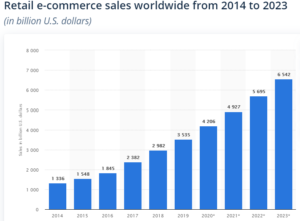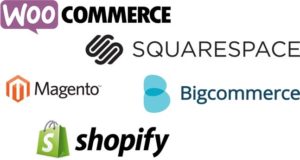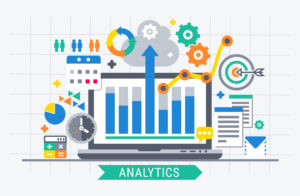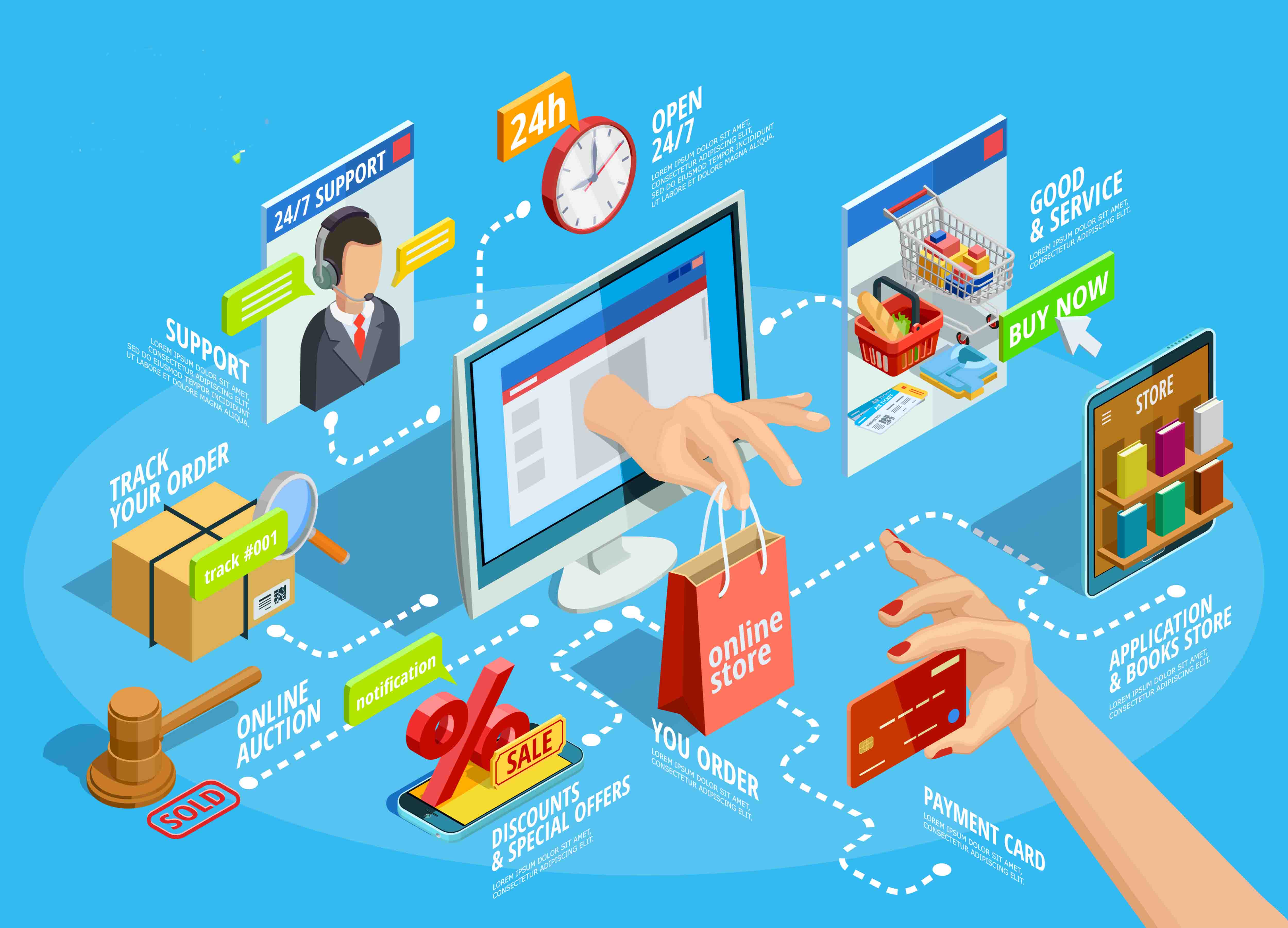A short guide for the bewildered to the things you have to consider once you have decided to go online with your business.
As businesses and consumers try to survive through this unprecedented pandemic and lockdown it is no surprise that we are seeing a surge in eCommerce activity – given that all the alternatives are out of reach. Data from Statistica below show how eCommerce has been growing and was expected to continue to grow over the next several years so if you weren’t already planning for this then now you really have no excuse or option but to start your eCommerce project. I think one of the significant impacts of COVID-19 will be to accelerate the acceptance and growth of eCommerce as new groups of people are introduced to doing new things Online that they may not have considered previously – like grocery shopping.

https://www.statista.com/statistics/379046/worldwide-retail-e-commerce-sales/
That got me thinking about what help business people might need if they are just starting to think about going online for the first time – so here are some considerations and things you need to be thinking about before you jump into your Online eCommerce adventure. This is not a comprehensive planning list but a perspective on what you need to know and what is important to help you be successful as an eCommerce operator, all from the things I have learned in 25 years of being in this space (including some painful lessons along the way).
So if you are thinking about pivoting towards eCommerce then your mindset should include the following
• This will be a long term impact and change so don’t just do things for the short term
• Traditional retail will recover once the restrictions lift but it will be a changed environment and you will need to consider what you can learn about your customers and their expectations from what they experience online
• Every brand and retailer should be planning for at least 15-20% of your revenue to come from your direct online presence you cannot concede that space to your competition.
Why do you need to transition at least part of your business Online ?
The obvious short term answer is that eCommerce is the only way people can purchase many goods and services at the moment but that misses the real point. People’s expectations around accessibility and convenience have changed and if you cannot connect with customers in the way that they expect – which is increasingly online – then you will be missing out on where a bigger and bigger percentage of commerce will take place in the future.
The other reason is that it gives you a different (and sometimes deeper) connection to your customers and a means to connect with them digitally and to understand what they are looking for and what solutions you can provide for them. The best online merchants understand that this is a two-way street and use their connected customers to guide their direction and decisions in a way that is much more difficult to do in the bricks and mortar world. Your customer list and the consent you have collected to engage and market to that audience is a real measure of the value of your business into the future. This is important to focus on because it is the only way to counter the reduced loyalty people generally feel online and the fact that there is a world of competition only a click away.
Don’t concede the planning field to your competition by staying off the pitch.
What do you need to consider when moving Online?
Setting up a real online presence and eCommerce operation can seem daunting and yes there is a lot to consider and a lot to get right. Thankfully the technology pieces have matured a lot and it is significantly easier to do now compared with just a few short years ago. With the existence of robust and secure cloud-based services, many of the real technical and security headaches have been reduced.
So here is my shortlist of things to think about (there are others but I consider this the key starter set).
- Business Strategy
- What is the need?
- What is your unique selling point?
- The Team
- What skills do you need in house?
- What can be outsourced?
- Product Data and Content
- Text Images and Video
- Technology Requirements
- eCommerce Platform
- Analytics Tools
- Email Platform
- Finding Your Audience and Driving Traffic
- Search Engines Paid and Generic
- Mobile Advertising and Programmatic Display
- Social
- Referral
- Customer Service and Support
- Communication Channels
- Transparency
- Immediacy
- Advocacy, you need to create brand champions
- Tools to Scale and Grow
- Improving Conversion
- Speeding Response times
- Managing Your Inventory and Supply Chain
- Accounting and Task Management
Business Strategy
As Jack Welch famously said ‘If you don’t have a competitive advantage, don’t compete’ So just because you build a website, customers will not just come and buy from it – if only things were that simple.

Traditional advantages like geographic location or pricing are much harder to sustain online than in the real world.
Pricing is very transparent (and expected to be) online so if your business model is all about hidden discounts or rebates, you might be in trouble. Being the cheapest is not always desirable or necessary but you do need to be competitive. You need to think differently about what you bring to the table that will encourage people to buy from you. If you are expert in sourcing niche products that is good. If you can use your expertise to help people make the right choices that is great because often the problem online is too much choice and knowing who to trust. If you provide a niche or specialised product then even better this is the channel for you.
Local can still be a good reason to differentiate but that does limit the audience you are addressing.
Your store must talk about who you are as a brand or retailer, what your mission is, what you believe in and why people should buy from you. If you can’t articulate this then you will be at a disadvantage.
Your thinking needs to change not to where am I located in terms of footfall but who is my audience, what are the problems I can solve for them and how do I connect to them digitally.
Faceless and soulless eCommerce stores don’t do as well as someone who is clear about their mission which should always be about more than just selling the next widget. People buy from people they trust and sometimes like. Your store has to deliver this. Givers gain in this economy.
Product Data and Content
The biggest change for most businesses is that now they are in the content business, which for most, is challenging and something new. Luckily, there are many tools to help, and the means of creating content, thanks to smartphones, etc., has become a lot easier.
First off, if you are selling products, you need great product descriptions, features, but also benefits. If you have content showing the product in use, that’s great. If you don’t, consider creating it for your top 20 products. You need high-quality product images and as many as possible per product.
There are no ifs, buts, or maybes with this. Nothing will sabotage your online eCommerce quicker than poor product descriptions
But outside of that, your store will need the following content also
- Trust and empathy-building Content
- About Us
- Why Buy from Us
- Our Story
- Detailed shopping information crucial to helping the customer feel secure
- Contact Us
- Shipping Details
- Refund and Return Policies
- Terms and Conditions
- Privacy Policy
You must be clear how you will treat your customers, and it must be written a plainly as possible.
The biggest trust signal for a business is still a real phone number. We assume that if we see a phone number, that the company is real, and if I get in trouble, I can pick up the phone and call them. It should be obvious and prominent – don’t make it difficult to find like some Utility companies. An obvious phone number also helps your conversion rate.
By the way, many online stores also do a significant proportion of their business over the phone – up to 20 or 30% in some cases – so plan for that early on.
Using Video is also almost a necessity these days for your content. If not for product descriptions, certainly for communicating about your store and operation. Video will certainly be needed to engage your audience. Some stores report that conversion rate (the ratio of people who purchase a product) can increase by 174% if they watch a product video. I guess maybe those late-night TV shopping channels may have sold some stuff in the past!
One of the decisions you will need to make early on is what video platform to use. YouTube is a good starting point, but you may need to invest in a paid platform like Vidyard or Wistia in order to have more control over the customer experience – it is worth it in the long-term.
Technology Platforms
You might be surprised that I didn’t look at this first, but in truth, you want to run a business, not become an IT expert. IT will become a bigger part of your world as an eCommerce operator, but if you don’t get your strategy and mission correct first, and have good content, then no platform will save your enterprise.

Thankfully, the technology part has become a lot easier in the past couple of years with the advent of several cloud-based services that take away the hosting, security, and maintenance headaches for you.
Your eCommerce platform needs to do the following things for you:
- Content management including product and non-product content
- Product search
- Provide shopping cart capability
- Product management
- Pricing
- Order management
- Payment systems
- Inventory management
- Business logic
- Integration with shipping and other providers
There are many platforms available and they generally work fine. Here are my recommendations…
If you have invested a lot in your current website and content, and it is on WordPress, then WooCommerce as a plug-in works very well. There are lots of developers and add-ons out there that will help you get integrated, and up and running quickly. If you are currently on a WIX site, then there are add-ons here that will work fine for a basic setup and for a limited catalogue.
Outside of that, generally, Shopify is the best online option for merchants.
- With 200,000 or so stores, it’s the largest eCommerce ecosystem around at the moment. There are lots of add-ons and integrations that solve many of the business requirements you will have down the road
- It’s a cloud-based SaaS Service. So, it is fast, will scale as your business grows, and you don’t need to worry about security, maintenance, and backups – that is all looked after for you
- Integrates into the social media space (this is where it started from)
- Works on mobile phones
- Has point of sale options for merchants (offline type support)
There are, of course, BigCommerce and Magento that deserve mentions, as well as several others. So, this is a decision you need to consider and will be specific to your circumstances, but in most cases, Shopify will provide you with what you require, and they are also developing their enterprise-level capabilities.
eMail Platform
It might seem strange to elevate email to the same level as the platform decision, but I do count eMail as one of the core decisions you need to get right from the start. The reason this is important is, to build relationships with customers, you need to interact with them regularly, and while social media has its place in this, you will be sending a lot of emails.
The first mistake is to think of email as pushing discounts and offers. Think about it, if a shop assistant followed you around a real-world shop saying nothing other than having 5% of that or 10% off that, you would be irritated and chances are, you would leave. Email is the mechanism to send content that builds trust and empathy with your store or brand. Emails need to be useful, engaging, and interesting to your audience. In order to do that, your email platform has to have certain capabilities. Done right, email as a channel, can/should drive up to 30% of the revenue in your eCommerce store. It is still the most affordable and scalable marketing channel available to you.
To do effective email, your platform needs to do the following:
- Provide contact tagging so you can create dynamic lists and move people between those lists automatically based on the actions they have taken.
- Smart Automation of emails and triggers – like what pages they visited on your website.
- Provide a good email template collection and builder, as well as A/B
- eCommerce data integration so the two platforms can talk and allow you to execute the right actions based on data.
- Helpdesk integration. Customers expect a seamless experience. Everyone needs to be able to see the entire customer communication context. Customers hate having to repeat information a second time.
- Smart send and scheduling options. Different times in the future for example.
You will need to manage multiple lists and sequences:
- Bucket list of all subscribers
- Pre-purchase subscribers
- Post-purchase subscribers
- Abandoned carts sequence
- Lists for offers that were opted into
- Dynamic lists based on audiences from your website
To engage and nurture your customer base, they likely will be getting one or more emails a week. Never overdo it, and make sure they are tailored and relevant. To manage that, you are going to need a little help from your platform. While there are tons of them out there, and things like MailChimp work well in a variety of situations, the two that I would recommend are Klaviyo and Active Campaign.
Klaviyo was designed as an email platform to support eCommerce, but I also use Active Campaign with several clients as a very affordable platform that is really feature-rich (for transparency I am an affiliate partner for Active Campaign). As an added benefit, their support team is very good and now generally based in Dublin.
Good content shared correctly via email will have a dramatic impact on your sales performance.
Analytics
The reason eCommerce is different from a traditional business is the level of data and understanding you can develop about your customers. What they look at, where they leave your site, who is coming, and when. To have this, you must have Analytics installed, and more importantly, configured correctly. Depending on your eCommerce platform, that can be easy or difficult.
For most people, there is only one game in town, which is Google Analytics. There really is no need to look at anything else. While it is frightening for some people, I am still surprised by the number of people I meet with websites and online stores who do not have a good grasp of what their data is, or what it is telling them.

Anyone can get up to speed, but be prepared to invest time (get some outside help where needed) to learn your way around the analytics, be able to pick the right performance metrics, and to make sure you make the right decisions based on reliable data (I talk about the right KPI’s in a different post). At a minimum, you will need to build the right goals and funnels in your analytics application to understand where people are starting their shopping journey, and where they are exiting before completing a purchase. That way, you will understand what parts of your content are not working and what needs to be improved, including parts of your site.
Finding Your Audience and Driving Traffic
This is often a separate world and a lot of what I do with clients. So, what are the key elements?
You have to invest at the correct level to drive traffic.
You need to understand the value of every sale or the lifetime value of every new customer, as that tells you what you can afford to spend to acquire that sale. When you know the cost per acquisition, you can afford to make sure all your campaigns are measured against that.
It takes a mix of different channels. Up until recently, most analytics gave all the credit to the channel that created the last click before the customer purchased. The world is a little more complicated, so you need to at least understand attribution modelling and if you should use it between your different channels.
Your traffic typically will come from generic search engine traffic where people find you because you rank in Google (or Bing) for search terms in different locations. This is still one of the best sources of traffic as it brings people to your business for the things you are providing. While you don’t pay directly for that click – you have to invest some time and money into ensuring that you can be found.
Paid search, while it can be expensive, is also the fastest route to getting traffic since it will take six to eighteen months for your search engine optimization efforts to yield results. Paid, on the other hand, should see traffic as soon as you launch the campaign.
Google does provide more support to allow you to set up your campaigns, but generally, I would advise having an expert do that for you and engage them on some sort of basis to continually review and optimise those campaigns. That investment should more than pay for itself in terms of better spending and reduced waste.
Social media allows you to push your content to an audience. The better you are at building that audience, and understanding it, the better the results. The same can be said for programmatic display – those ads that appear when you visit other websites.
Referral traffic is also great, and as you get established, you should put into place specific programmes to drive this.
Customer Support and Operations
From day one, you must be maniacally focused on customer support and customer satisfaction to run a successful eCommerce business. That means that every time a customer sends you a message, you must make sure it is handled correctly and on time. On-time normally means responding in 12 to 24 hours. So, once the volume increases, you will need a Helpdesk (or ticketing system) to make sure you capture each communication, and that it gets assigned to the right person and gets handled on time.
Again, there are lots of possibilities, but Zendesk is probably the most popular and provides all the integrations you need.
This is also why you must be clear and transparent about your terms and conditions, refund policies, etc. You always have to treat your customers correctly and fairly. If you don’t, you won’t last long in this space.
Also, customers rate the entire experience of how your web store performs, how the product performs, how your courier or delivery service performs, etc. So, if your courier screws up and does a bad job, you have to fix it for the customer and then manage that with your courier partner. Do not pass the buck (or parcel!) since a customer will hold you the merchant responsible for the complete experience.
Delivery experience is also the piece that can make you or break you in this space.
While I’m at it, again, do not neglect the phone. Customers need to see a phone number they can call if they need the help of support, and for many eCommerce stores, 20-30% of the sales come in over the phone – so be there where your customers want you to be.
Live chat is also a key expectation for today’s consumer. It is generally very easy to integrate into your site. Message the times when you are available for live chat and collect email addresses and questions to respond to outside of those hours. Intercom or Olark are good options, among others.
Tools to Scale and Grow
One of the main reasons the technology platform choice is important is when you start to scale and grow the business there are many additional tools you will want to deploy. That is why ecosystems like Shopify and WordPress/WooCommerce are good because of the level of developer support that they have. You don’t want to be re-inventing the wheel every time.
Part of your arsenal when you get established will need to include:
- Review widgets
- Heat mapping ad session recording tools
- Coupon codes
- Exit intent banners
- Other social selling tools
To grow your business, you either need to find new customers, have your existing customers buy more frequently, or increase the average amount that they spend. Finding new customers tends to be more expensive than nurturing those you already have – which is why email is so important in this world.
Collecting reviews is important social proof and will help your conversion rate significantly. It also allows you to collect direct unfiltered feedback from your customers, which you can then act on. ReeVoo, Feefo, or Trustpilot and others are generally the go-to solutions here.
Heat mapping software allows you to see where people are clicking or engaging on your pages. It beats the endless hours of debate you will otherwise have with designers and web developers about what is important. The truth is until you measure it, you simply don’t know. My favourites are either Lucky Orange or Hotjar.
Exit intent banners are very important to growing your email subscriber list. Don’t annoy customers by presenting them with a popup when they reach your site, but rather when they are ready to leave and have not bought something. Use that time to capture their emails in return for some content of value or interest to them. It costs you money to get them to your site, so don’t let them leave empty-handed if you can avoid it.
Conclusion
In the face of most adversity, some opportunities present themselves, and for many businesses, it is hard to think beyond this present week. That is understandable, and we all have to be patient with each other and support everybody as best we can until we get out the other side of the worst of this pandemic. Rest assured, we will come out on the other side of this, but we will emerge into a different world post-COVID-19. I think eCommerce will continue to accelerate in that world, and we will all be more familiar and comfortable with using video, video conferencing, and messaging apps. This trend was underway, and the recent restrictions will only serve to accelerate it.
I’ve been involved with eCommerce projects both as a technology provider, and an eCommerce business owner, for almost 25 years. It is an exciting space, exhausting at times, but exhilarating when you see the successes. This article is a very high-level skate through the things I believe you need to have front and centre in your thinking as you move towards setting up your eCommerce business. There is always more detail and more options to consider. However, the key to success in eCommerce is not in the technology (although that helps greatly). It is about acting like a business, showing up every day, doing the right things by your customer, and doing them consistently – that is what will give you the best chance of success.
Need help? During this Covid-19 crisis I’m happy to help with any advice our guidence I can provide. You can book a Free One Hour Consultation by Clicking this Link.
Alternatively, head on over to the eCommerce Association of Ireland’s Website at www.ecai.ie. We are putting together a rich community of traders and mentors. Register there to get paired up with a mentor, someone who has volunteered their time to help businesses get online and continue to trade through this period of difficulty. #ecomtaskforce #stayhome #staysafe


